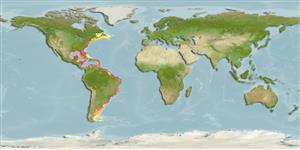Common names from other countries
>
Anguilliformes (Eels and morays) >
Ophichthidae (Snake eels) > Myrophinae
Etymology: Myrophis: Greek, myros, -ou = male of morey eel + Greek, ophis = serpent (Ref. 45335).
More on author: Lütken.
Environment: milieu / climate zone / depth range / distribution range
Ecología
marino; salobre asociado a arrecife; rango de profundidad 0 - 100 m (Ref. 5951). Tropical
Western Atlantic: Bermuda and North Carolina (USA) to Brazil, including the Gulf of Mexico, the West Indies, and the coast of Central America. Also throughout Caribbean (Ref. 26938). Northwest Atlantic: Canada. Records from the eastern Atlantic need confirmation.
Tamaño / Peso / Age
Maturity: Lm ? range ? - ? cm
Max length : 35.3 cm TL macho / no sexado; (Ref. 30499)
Pale brown, with a fine peppering of black spots on the back and sides of the body; ventral surface is light (Ref. 30499).
Inhabits seagrass beds from bays and mangroves to offshore reefs. Adults move to open sea to spawn. The species has considerable regenerative powers (Ref. 5521). Tidal creeks and brackish estuaries offshore to depths of 7 m (Ref. 26938). Reported from fresh water in Nicaragua, Costa Rica, and Mexico (Ref. 30499). Caught for bait fishery with use of ichthyotoxic plants (e.g. 'cunabi') along the north Brazilian coast (Ref. 34896).
Life cycle and mating behavior
Maturities | Reproducción | Spawnings | Egg(s) | Fecundities | Larva
Robins, C.R. and G.C. Ray, 1986. A field guide to Atlantic coast fishes of North America. Houghton Mifflin Company, Boston, U.S.A. 354 p. (Ref. 7251)
IUCN Red List Status (Ref. 130435)
CITES (Ref. 128078)
Not Evaluated
Threat to humans
Harmless
Human uses
Pesquerías: comercial; carnada: usually
Herramientas
Special reports
Download XML
Fuentes de Internet
Estimates based on models
Preferred temperature (Ref.
115969): 12.5 - 27.8, mean 24.4 (based on 774 cells).
Phylogenetic diversity index (Ref.
82804): PD
50 = 0.5078 [Uniqueness, from 0.5 = low to 2.0 = high].
Bayesian length-weight: a=0.00076 (0.00029 - 0.00199), b=3.06 (2.83 - 3.29), in cm Total Length, based on LWR estimates for this (Sub)family-body shape (Ref.
93245).
Nivel trófico (Ref.
69278): 4.1 ±0.7 se; based on size and trophs of closest relatives
Resiliencia (Ref.
120179): Alto, población duplicada en un tiempo mínimo inferior a 15 meses (Preliminary K or Fecundity.).
Fishing Vulnerability (Ref.
59153): Low to moderate vulnerability (25 of 100).
